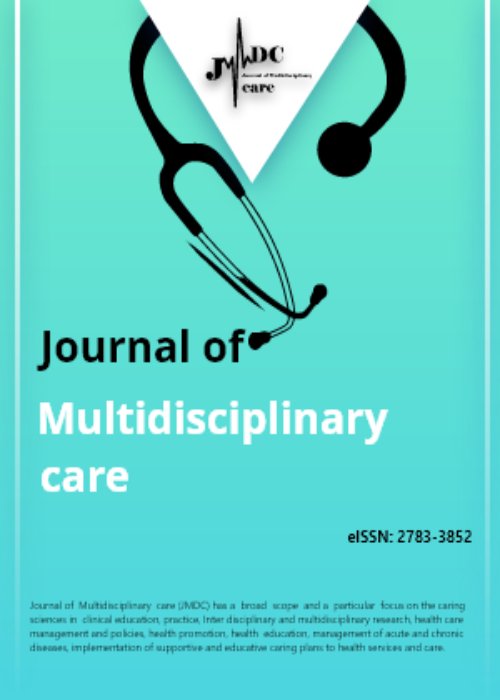فهرست مطالب

Journal of Multidisciplinary Care
Volume:12 Issue: 1, Mar 2023
- تاریخ انتشار: 1402/05/23
- تعداد عناوین: 8
-
-
Pages 3-11Background and aims
This study aimed to identify the status of social media addiction (SMA) and some related factors in nursing and midwifery students in Iran.
MethodsIn this cross-sectional study, 284 Nursing and Midwifery students participated. The study was conducted from October 4, 2021 to February 16, 2022. Sampling was done by simple random method. The data collection tool was Bergen’s Social Media Addiction Scale (BSMAS). Data analysis was performed using SPSS version 22. Pearson correlation and multivariate linear regression tests were used to analyze the data.
Results234 (82.39%) of the students had some level of social media addiction. There was a statistically significant relationship between the hours of using social media during the day and the duration of using these media with addiction (β = 0.537, P < 0.001). There was a significant relationship between SMA and living single and independently (β = 0.58, P = 0.032). SMA had no significant relationship with other demographic characteristics of students (P > 0.05). A statistically significant relationship was also between SMA and students’ academic performance (β = -0.412, P < 0.001).
ConclusionThe prevalence of SMA in the study population was alarmingly high. This emerging social problem should be considered in the community of nursing and midwifery students. Because this type of addiction can affect the quality and quantity of nursing care, with the development of attractive social networks dedicated to education and learning, these networks should be directed toward useful student goals.
Keywords: Addiction, COVID-19, Social media addiction, Smartphone, Internet addiction -
Pages 12-17Background and aims
Emergency medical technicians (EMTs) are healthcare professionals caring for COVID-19 patients. The prolonged pandemic may lead to fatigue and threaten caregivers’ mental health. Therefore, this study aims to investigate the level of stress, depression, and anxiety among EMTs in Zanjan during the third year of the COVID-19 outbreak.
MethodsThis cross-sectional study was conducted on 194 EMTs from Zanjan University of Medical Sciences, Iran, between June 2021 and September 2021. participants were selected using random cluster sampling. Data collection involved using a demographic questionnaire and Depression, Anxiety and Stress Scale-21 Items (DASS-21). Data were analyzed using SPSS version 24.
ResultsAll participants in the study were male, with a mean age of 33.46 ± 7.25. The mean and standard deviation of depression, anxiety, and stress were 3.12 ± 3.03, 2.24 ± 2.38, and 4.16 ± 3.27, respectively. A significant association was found between the mean score of anxiety and the number of missions and between the mean score of stress and the number of tasks, age, and work experience (P < 0.05).
ConclusionThe level of depression, anxiety, and stress among EMTs was within the normal range. The prolonged pandemic may have helped EMTs adapt to this critical situation. However, it is essential to note that this study was conducted on a limited group of EMTs, and socio-cultural contexts influence psychological characteristics. Therefore, further research in this field is necessary in the future.
Keywords: Stress, Anxiety, Depression, Emergency medical technicians, COVID-19 -
Pages 18-23Background and aims
The COVID-19 outbreak has caused many psychological problems among different groups of society, particularly hemodialysis patients. There is little data on the benefits of resilience as a protective factor for adaptation to specific and threatening situations in such patients. Hence, this study aimed to examine the effects of training based on Bandura’s self-efficacy theory on the resilience of hemodialysis patients in the southeast of Iran in 2020 during the COVID-19 outbreak.
MethodsThis quasi-experimental study was conducted on 140 hemodialysis patients in southeast Iran. The participants were selected by convenient sampling and randomly assigned to control (n = 70) and experimental (n = 70) groups. Educational content was provided over ten sessions of face-to-face 20-30 minutes to the experimental group, and the control group received routine training. Data were collected via the Connor-Davidson Resilience Scale and analyzed by SPSS version 16 using descriptive and inferential statistics.
ResultsThe mean resilience scores in the experimental and control groups before the intervention were 51.94 ± 11.11 and 53.79 ± 16.04, and after the intervention, 53.27 ± 10.39 and 73.86 ± 13.16, respectively. There was a significant difference between the two groups after the intervention (P < 0.05).
ConclusionThe findings denote the self-efficacy training program based on Bandura’s theory improved resilience in the patients undergoing hemodialysis during the COVID-19 outbreak. Hence, nursing planners and policymakers are recommended to develop some measures for facilitating self-efficacy training programs for hemodialysis patients.
Keywords: COVID-19, Hemodialysis patients, Resilience, Self-efficacy -
Pages 24-30Background and aims
This study aims to investigate the effect of psychological intervention based on the mobile application on the anxiety level of laparoscopic cholecystectomy candidates.
MethodsThis semi-experimental was conducted on 60 laparoscopic cholecystectomy candidates in 2022 in Shahrekord. The participants were randomly divided into control and test groups using the block randomization method. The test group received a psychological intervention based on a mobile application installed on their mobile phones and used for two months. The control group received usual hospital care only. Data were collected before, immediately after, and two months after the intervention using the Spielberger Anxiety Questionnaire. Descriptive and inferential statistics (chisquare, Fisher’s exact test, independent t-test) were used to analyze the data in SPSS 24 software.
ResultsBefore the intervention, the average scores for state anxiety in the test and control groups were 45.97 ± 11.71 and 46.00 ± 11.10, respectively. The average scores for trait anxiety were 43.60 ± 10.24 and 44.37 ± 10.55 in the test and control groups, respectively. There were no significant statistical differences between the groups regarding state anxiety (P = 0.99) and trait anxiety (P = 0.78). However, immediately after the intervention, the test group showed significantly lower scores for state anxiety (P = 0.01) and trait anxiety (P = 0.04). Additionally, two months after the intervention, there was a significant difference in the average scores for state anxiety (P = 0.03) and trait anxiety (P = 0.02) between the two groups.
ConclusionPsychological intervention based on a mobile application can be an efficient and costeffective way to manage anxiety in cholecystectomy candidates.
Keywords: Psychological intervention, Mobile application, Anxiety, Cholecystectomy -
Pages 31-38Background and aims
Sports activities positively reduce mental disorders, especially in critical situations. Therefore, this research aimed to investigate the effect of sports activities on corona anxiety with the mediating role of professional identity in the treatment staff of Ilam province.
MethodsThis research was applied, and its method was descriptive-cross-sectional. The statistical population of the research was all the treatment staff of Ilam province, which was selected using Morgan’s table and stratified sampling method, with 320 people for the sample. Four standard questionnaires on coronavirus anxiety of Alipour et al, the physical activity of Baecke et al, and the professional identity of Hao et al were used to collect data. The structural equation model (SEM) was used to analyze the data with the help of SPSS-22 and Amos-22 software.
ResultsThe mean and standard deviation were obtained for the variables of sports activities ,(X̄ =2.65, S=1.72) corona anxiety (X̄ =3.23, S=2.25), and professional identity (X̄ =3.30, S=3.77) The research showed that sports activities (β = -0.19, t = -2.808) and professional identity (β = -0.29, t = -2.624) have a negative and significant effect on corona anxiety, and the mediating role of professional identity in the relationship between sports activities and corona anxiety was also confirmed (β = 0.55, t = -3.766).
ConclusionBased on the research results, the mediating role of professional identity was confirmed. Therefore, strengthening the professional identity through training causes the treatment staff to understand more about the need to participate in sports activities and, as a result, reduces their anxiety about the coronavirus.
Keywords: Corona anxiety, Professional identity, Sports activities, Treatment staff -
Pages 39-45Background and aims
Evidence shows that the intention to leave negatively impacts nurses, patients, and health care systems. This study investigated the relationship between intention to leave, job satisfaction, and nurses’ burnout in Basra, Iraq.
MethodsThis cross-sectional and descriptive study was conducted in three teaching hospitals in Basra from 2022-2023. The sample consisted of 238 nurses selected through convenience sampling. Data was collected using a demographic information form, intention to leave scale, Minnesota Satisfaction Questionnaire (MSQ), Copenhagen Burnout Questionnaire (CBI), and 12-item General Health Questionnaire (GHQ-12). Data was entered into SPSS 20 for analysis.
ResultsThe mean scores for intention to leave, job satisfaction (MSQ), and burnout were 9.69 ± 4.50, 70.93 ± 13.74 and 64.14 ± 19.06, respectively. Job satisfaction had a negative coefficient of 0.021 on “intention to leave” (P < 0.001). Higher levels of burnout with a coefficient of -0.028 were associated with an increased intention to leave (P < 0.001).
ConclusionThe nurses in the study expressed an intention to leave, and this issue was related to job satisfaction and burnout. Hospitals can enhance the overall quality of care by prioritizing job satisfaction, preventing burnout, and implementing strategies to retain nurses. Health policymakers should consider these factors in decision-making processes and take necessary measures to improve and promote them.
Keywords: Intention to leave, Job satisfaction, Burnout, Nurse -
Pages 46-55Background and aims
Domestic violence against women is a problem that might cause irreparable damage to women’s health. This study aims to review the studies on the strategies regarding domestic violence against women in Iran.
MethodsThis study is a narrative review of published articles on strategies to prevent domestic violence against women in Iran from 2009 to 2019. Two scholars on valid databases searched. Articles were selected based on the time and setting of studies, purpose, and research structure framework. The full text of the articles and the publication language were included in the study. The quality of the articles was assessed using the “checklist of original research articles,” which comprises five sections; the structure of the abstract, the title and introduction, the review method, the results, the conclusion, and the keywords. The general opinion of the reviewer was also taken into consideration.
Results13 eligible articles were reviewed, including 11 in Persian and 2 in English. The finding of the reviews indicated the interventions implemented to reduce and prevent domestic violence against women in Iran. These interventions focused on life skills in three categories (a) Communication and Interpersonal Skills (such as resilience based on spirituality, mindfulness techniques, motivational interview, and emotionally focused couple therapy), (b) decision-making and critical thinking skills, including problem-solving, decision-making, narrative exposure therapy, and conflict resolution related to domestic violence against women), and (c) coping and self-management skills (such as anger management, marital adjustment, and self-defense).
ConclusionThe effective implementation of life skills can serve as practical methods to prevent domestic violence against women.
Keywords: Domestic violence, Women, Iran


